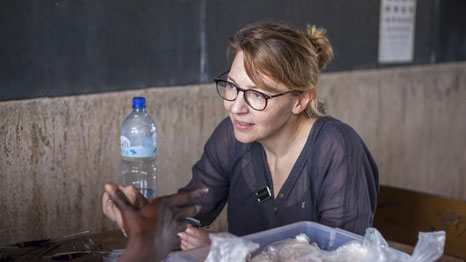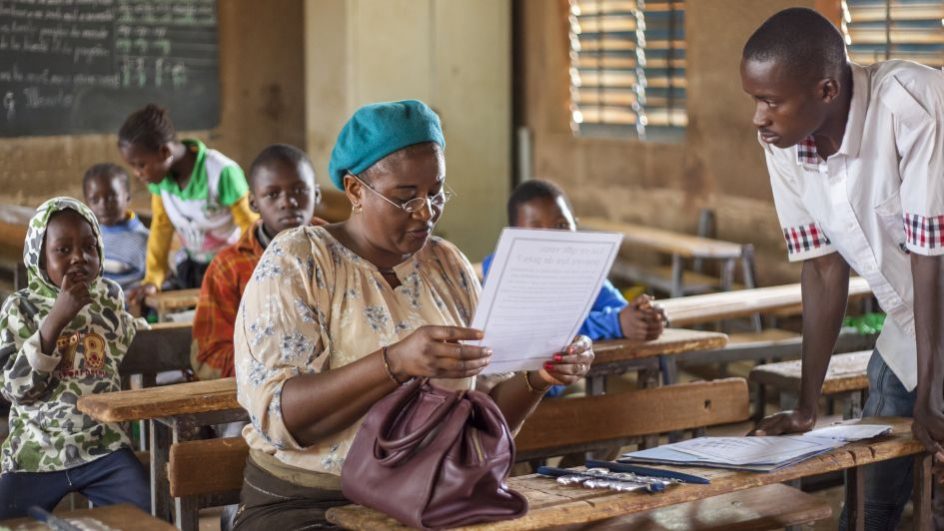
»Children unable to see the teacher or the blackboard in overcrowded classes have little chance of a good education.«
One pair of glasses – endless opportunities
Experts estimate that around 700 million people worldwide have no access to glasses – and are thus disadvantaged in education, social interaction and the labor market, because they are unable to perform many activities. The OneDollarGlasses Association, winner of the first empowering people. Award 2013, manufactures affordable glasses for developing countries, and has to date produced and distributed more than 100,000 pairs of glasses worldwide. The association is currently active in 8 countries. OneDollarGlasses has also been active in West African Burkina Faso since 2013, and since 2015 Siemens Stiftung and OneDollarGlasses have been working together as part of a project partnership lasting several years in an effort to provide access to glasses for the small-town and rural population as well.
Christine Meinhardt is project manager in the development cooperation department of Siemens Stiftung and has visited OneDollarGlasses on site.
Burkina Faso rarely features in the European media. How did you imagine Ouagadougou before you went and what were your impressions?
I am often travelling to Kenya due to my project work and have also travelled to some other West- and South African countries. For me, it was my first visit to West Africa. Due to its central location, Burkina Faso has always been a transit country. The people there are accustomed to influences from the outside world, which has led to the local society being very open to all things foreign to them. This is remarkable given that Burkina Faso is one of the poorest countries in the world. The country is very rural – rarely do you see a multi-story building, not even in the capital, Ouagadougou. As soon as you turn off onto a side street, you have the impression of being in a village, as only a few streets in the city center are tarmacked. In the rainy season (May to September), you can also come across a “holy” crocodile crossing the road – as this is when they like to come out of their ponds in the city park and take a walk through the surrounding neighborhoods. That did not happen to us, because I was there during the dry season in temperatures of over 100 degrees F. This also took a bit of getting used to for a Central European, who had just left winter behind them in Germany.
In Burkina Faso, an above-average number of people are struggling with eye disorders and defective vision. What are the reasons for this?
Burkina Faso is located on the edge of the Sahel. In hardly any other place in the world the sunlight is more intensive, and also there is always fine desert sand in the air. Without protection in the form of a sun hat and sunglasses, these are extreme conditions for the human eye. Most Burkinabe are either unaware of the extremely harmful effects of the sun or do not have the financial means to protect themselves properly. The kids are especially hard hit. OneDollarGlasses estimates that numerous children and adolescents under the age of 16 already have defective vision or are suffering from the early stages of cataracts. That is also why it is so important that OneDollarGlasses opticians systematically visit schools, carry out eye tests and then provide free glasses for those who have defective vision. Due to the high birth rates, schools are overcrowded anyway – in the capital Ouagadougou alone, the population grows by around 250,000 every year, with population growth being no less rapid in rural areas. Children who cannot see the teacher let alone the blackboard in the crowded classrooms have little chance of getting a good education.
Needless to say, the strong sunlight also has a huge impact on people in adulthood. In addition, there is the typical, age-related decline in vision, which in many cases makes reading glasses necessary for people over the age of 40 even here in Germany. The proportion of adult Burkinabe who need glasses and who do not have adequate access is extremely high and, according to estimation by the team, is around 30-40%.
What are the aims, or was the project plan, when Siemens Stiftung decided to support OneDollarGlasses in Burkina Faso?
When we started the cooperation between OneDollarGlasses and Siemens Stiftung in 2015, we agreed on three overarching goals: First, the expansion of the project into smaller cities and rural areas, with 75% of Burkina Faso’s around 19 million inhabitants living in the countryside. To achieve the goal of providing as many people as possible with glasses, expanding services to rural areas is therefore unavoidable. Secondly, we have agreed to try different distribution channels to find out how we can make the combined business model of selling glasses at an affordable price on the one hand, and the free provision of glasses to school children on the other hand, profitable in the countryside. Achieving profitability and securing the local organization in the long term is, of course, easier in high-density cities. Profitability in the countryside can only be achieved through the most efficient distribution channels, because high transport costs, long distances, poorly developed routes and fewer customers make selling in rural areas time and cost intensive. Thirdly, it is not possible without a good and dedicated team! We have therefore pledged our financial support in the further development and expansion of a capable and competent team and efficient local organizational structures for 3 years.
What is the OneDollarGlasses business model in Burkina Faso?
The strategy in Burkina Faso is similar to that in other developing regions. First of all, it’s about analyzing feasibility, market potential and partner landscape. This involves recording regulations in the local health system as well as any existing personal connections to the respective region. A team is then formed from a neighboring OneDollarGlasses location that takes care of the involvement of the local authorities, followed by a suitable location and the construction of an OneDollarGlasses spectacle center, the recruitment of young people to receive training as opticians and the sales launch. In Burkina Faso, the glasses are currently produced in the central workshop in Ouagadougou. The 9 shops at present are then supplied and adapted directly in the shop, at mobile sales events, so-called ‘outreaches’, and in schools by the OneDollarGlasses employees. Statistically, in Burkina Faso, there is one optometrist to several hundred thousand patients, reflecting how defective vision is currently hardly recognized. These work mostly in the urban health centers and refer patients to expensive eyewear shops, which charge prices of between 50 and 120 euros and as a result naturally can pay high commissions to the referring opticians and doctors. What remains are the people in the city, who cannot afford these prices, as well as the people in rural areas, who simply are not offered any services.
This supply gap is closed by OneDollarGlasses with a business model selling the glasses for an average of 8 euros. This price covers the material costs as well as the costs of production and sales and thus makes it a sustainable concept. First, they were only three, meanwhile, nearly 50 people work in management, production, sales and distribution. In 2017, sales of glasses even doubled, covering almost all local running costs.
Caring for children is very time consuming, how does the local OneDollarGlasses team go about dealing with schools?
Another one of our aims is to also offer the widest possible provision of eye care at the schools in Burkina Faso. This means the team is on the road a lot, which sometimes also takes them to remote village schools. For example, we were at the school „Ecole Pissy“ at one end of Ouagadougou. This was also where the Plus Optix device was used, a professional vision screening device that does not replace the conventional eye test with different sized letters on the wall, but quickly identifies those children without vision disorders, so that the refraction, i.e. the assessment of the necessary vision correction, is much faster. This means that, instead of about 100 children, the OneDollarGlasses team can test as many as 400 children. Immediately afterwards, the glasses are adjusted on site in the schools and given to the child. The children are allowed to choose a personalized decoration, e.g. colored glass beads. It is very moving when a child and also older people are almost overwhelmed by the sights they see around them thanks to their new glasses. By the way, not only the children, but also the adults have high demands on the quality and design of the glasses: In addition to the original oval shape, there are now rectangular glasses, sunglasses with prescription lenses and frames with double arms – depending on the use and individual taste. For the OneDollarGlasses opticians and employees, it is even a good thing for everyone to wear their own design. Now, if that isn’t identification with the company!
After your trip, what are your expectations as to how OneDollarGlasses will continue to develop in Burkina Faso?
OneDollarGlasses has undoubtedly arrived in Burkina Faso. On the basis of the sheer harmony, creativity and ambition I experienced there, I can only say that they are there as a team and social business, where everyone would like to be – namely, pursuing a successful and meaningful activity that makes many people happy and gives them a life perspective again. The team has now grown to 49 employees. The nine shops in Ouagadougou, Kaya, Tenkodogo, Bobo-Dioulasso, Koupéla and Fada sell glasses profitably to the local population, including reading and sunglasses. This year, another 6 shops will be added, an initial outreach in Banfora sold 300 pairs of glasses in one day. If you take all these developments together, we are now realistically talking about reaching the long-term break-even point in 2020/2021. This is a fantastic success, which we are of course all delighted about at Siemens Stiftung. OneDollarGlasses stands for what we believe in – namely, combining technologies with a sustainable business model to compensate for deficits in basic services and to create jobs. With its success story, OneDollarGlasses is a major source of inspiration and motivation for many more inventors and social entrepreneurs within the empowering people. Network, who also help to improve the lives of people in developing regions with their own inventions.
April 2018
Christine Meinhardt
+49 9131 9207 913



